Manuscript accepted on :30-Aug-2018
Published online on: 18-09-2018
Plagiarism Check: Yes
Reviewed by: Mandar Malawade
Second Review by: Karthikeyan C.
Final Approval by: Dr. Mohamed Abdel-Daim
Haritha Murali, P. Lakshmi Prabha, Aishwarya Nair and Vishal R. Nair
Department of Biomedical Engineering, SRM Institute of Science and Technology, Kattankulathur, Chennai, Tamil Nadu, India.
Corresponding Author E-mail: harithamurali13@gmail.com
DOI : https://dx.doi.org/10.13005/bpj/1515
Abstract
People belonging to different age groups who suffered fractures, temporary limb paralysis, paraplegia and monoplegia and various stages of hypertension (High BP) need to carry out physiotherapy to regain motor control in the limb(s). So this limb flexion extension counter can assist the subject to exercise properly and independently recover with ease. This device will help to monitor parameters such as heart rate, temperature and limb flexion-extension counts. Using GSM module the readings will be transmitted directly via SMS to the subject’s phone thus helping the individual to keep a record of their workout. The microcontroller used is ARDUINO MEGA 2560 which interfaces the temperature sensor LM35, IR Proximity Sensor for limb flexion-extension count and the pulse rate sensor SEN-11574 along with the GSM Module. A goniometer is used for measuring the angle made between the limbs. The pressure is applied on the arm using an inflatable cuff which acts as the load or stress for doing the exercise. On bending the forelimb, the IR sensor glows thus showing as a count. The pulse rate sensor shows the varying pulse rates during exercise. The cuff pressure is maintained between 30-50 mm of Hg. The conclusion is that pulse rate and temperature are directly proportional to each other from preliminary tests and using wireless recording it is easier for the subject to store and maintain record of his/her progress.
Keywords
Arduino Mega 2560; Cuff Pressure; Flexion-Extension; GSM Module; Physiotherapy
Download this article as:| Copy the following to cite this article: Murali H, Prabha P. L, Nair A, Nair V. R. Wireless Recording of Limb Flexion-Extension Counter using GSM Module. Biomed Pharmacol J 2018;11(3). |
| Copy the following to cite this URL: Murali H, Prabha P. L, Nair A, Nair V. R. Wireless Recording of Limb Flexion-Extension Counter using GSM Module. Biomed Pharmacol J 2018;11(3). Available from: http://biomedpharmajournal.org/?p=22679 |
Introduction
With the development in the field of rehabilitation and physiotherapy, lives of people have improved to new levels. People who have been involved in accidents, mishaps and have or are still recovering from the after effects need to recuperate to their full strength. People approach dieticians and physiotherapists for assistance in bringing the functionality of their limbs to normalcy. In present scenario, physiotherapy. Normally physiotherapies are of various types depending on the type of problem. Hydrotherapy and aqua therapy are used for treating whole body symptoms or localised target points to develop overall well-being. For limbs nurses and medical staff help in movement by providing support in flexion and extension of muscles. He/ she assists the subject in moving the limbs say elbows, legs etc. This situation changes once the patient reaches home and becomes incapable of carrying out the activity to the fullest. For soft tissue cases massage is provided to reduce fluid build-up, break up scar tissue and increase blood flow to the muscles, which is done by a masseuse who is an expert in carrying out mobilisation. There are others also like accupunctures which are painful but highly effective and little risk associated. So we can state that there is a need of dependency upon others during rehabilitation which is avoidable but needed at times of need. There is a need of finding a non or minimally stressful, slow and progressive method of therapy which can enable the person to independently work on his/her progress and be independent and should be able to do it on his/her time. Booking appointments and scheduling sessions are always stressful and cannot be followed strictly with also the added problem is fitting time in your schedule depending on the physical condition the individual. Mostly people belonging to age group between 40-60 years need such types of restricted and controlled method of rehabilitation. They may be suffering from limb fractures, paraplegia, monoplegia, muscular dystrophy etc. This device enables the person to work in their own comfortable space at a respectable and reasonable speed. It measures the temperature, pulse rate, limb flexion and extensions along with cuff pressure. Continuous monitoring of vital parameters i.e. pulse rate, body temperature, flexion extension counts and angle between the limbs. The will be inflated to give the appropriate stress or load between 30-60 mm of Hg so as to prevent greater occlusion to the blood vessels.1 The microcontroller will be driven using a power supply of +5 V supply which will be controlling all the other sensors and the GSM will be used along with Arduino to deliver the signal directly to the person via text message.
Materials and Methods
Proposed Architecture
 |
Figure 1: Block Diagram of the limb flexion-extension counter incorporated with GSM based wireless transmission.
|
Figure 1 represents the block diagram of the limb flexion-extension counter. It has ARDUINO Mega 2560 as its microcontroller which is interfaced with the pulse rate sensor (SEN-11574), temperature sensor (LM-35) and the IR Proximity sensor. A BP cuff is placed around the arm of the subject so as to exert pressure on to the limb.2 The pulse rate sensor and the temperature sensor are placed on the fingers of the subject. The goniometer is fixed alongside the limb of the subject to measure the angle generated by the limbs. The GSM module is connected to the Arduino mega microcontroller for receiving the signals from Arduino board and transmitting it to the subject via SMS.
The component description are as follows:
Arduino Mega 2560
The microcontroller has 256 kb RAM along with 16 digital I/O ports out of which 6 ports can be used as PWM, 6 analog inputs. It also includes a reset button and an ICSP port. Its multiple compatibility features along with it being cost effective and flexible in use are its greatest advantages.
LM 35 Temperature Sensor
This sensor measures temperature and has an operating power supply of +5V and is most commonly used in measuring body temperature. It has a temperature range from – 55 to +150oC.
Pulse Rate Senor SEN-11574
This sensor measures the pulse rate of the subject by using plethysmography principle. It works at an operating voltage of +3.3V to +5V. It has receiver and transmitter on the same side. Therefore when the light passes through the blood and reaches the receiver, the corresponding reading give the pulse rate of the subject.
IR Proximity Sensor
This sensor sends an IR signal which when intersected or obstructed results in the glowing of the led thus denoting in this case a count. It has a receiver and transmitter IR LED. So in the absence of any obstruction or object the signal reaches the LED, thus no glowing of LED results in no count.
Blood pressure cuff
This cuff provides the load or stress on the limb of the subject by creating occlusion in the blood vessels within bearable limit. It has a pressure gauge using which we can regulate the pressure within the cuff.
GSM Module Board SIM 900A
This is interfaced with Arduino mega 2560 and transmits signals wirelessly similar to that of a mobile sim. It has a dual band of 900/ 1800 MHz. It has very low power consumption of 1.5 mA along with small form factor with the ability to call, text and fax data. It is easily compatible with ARDUINO Mega 2560.
Goniometer
This device measures the angles between the limbs so as to record the degree of extension and flexion to signify improvements. It is battery operated with a built-in LCD for clearing reading of angles.
Pulse rate sensing
The pulse rate sensor is interfaced to the Arduino board by connecting the wires as follow:
‘S’ of pulse sensor → ‘A0’ of Arduino
‘+’ of pulse sensor → +5V of Arduino
‘-‘ of pulse sensor → GND of Arduino
The formula for Heart Rate Calculation is:

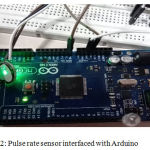 |
Figure 2: Pulse rate sensor interfaced with Arduino.
|
Body Temperature Sensing
By placing flat side of temperature sensor LM-35 upwards we can connect to Arduino Mega as follows:
Left tip → ‘+5V’ of Arduino
Central tip → ‘A2’ of Arduino
Right tip → ‘GND’ of Arduino
The sensor has a little delay before providing the correct readings.
Its flexibility, size and cost makes it easily usable.3
The temperature is calculated by using the given formula i.e.
Temp = 5.0*Analog Read(0)*1024oC.
 |
Figure 3: Temperature sensor interfaced with Arduino Mega 2560 board.
|
IR Proximity Sensor Sensing
The proximity sensor counts the number of flexion and extensions done by the subject and is interfaced to the Arduino board as follows:
‘OUT’ of sensor → A3 of Arduino
‘GND’ of sensor → GND of Arduino
‘VCC’ of sensor → +5V of Arduino.
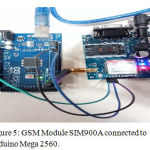 |
Figure 4: IR Proximity sensor interfaced to Arduino Mega 2560.
|
GSM – Arduino Interface
The GSM module is used for transmission of data from the source to the receiver wirelessly similar to mobile network transfer. The connections are very simple as given follows:
‘RxD’ of GSM Module → ‘TxD’ of Arduino Board
‘TxD’ of GSM Module → ‘RxD’ of Arduino Board
GSM module operates on +12V power supply.
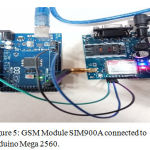 |
Figure 5: GSM Module SIM900A connected to Arduino Mega 2560.
|
Working
The cuff is placed around the limb (say arm) and a pressure between 30 – 50 mm of Hg is applied.1-2 The Arduino is powered up by connecting to a +5V supply and the temperature and pulse rate sensor are placed around the fingers of the subject using a velcro band to record the signals. The IR proximity sensor is placed over the cuff to denote the count of flexions and extensions done by the subject as shown in Fig. 6. The goniometer is fixed along the arm of the subject to denote the flexion angle produced between both the limbs. This is for providing the proof of improvement.9 The GSM is turned ON and a sim is inserted which in this case is a 3G sim via which the IR sensor, pulse rate and temperature sensor readings are sent to the subjects mobile as an SMS wirelessly.5 The subject will do flexions and extensions as shown in Fig.6-7 slowly and gradually till a count of 10-12 or till failure in a minute. Since occlusion of arteries more than a minute can lead to muscular pain and in prolonged cases increase the rigidity and degradation of blood vessels.2
So while exercising continuous monitoring of pulse rate and temperature is observed along with constant measurement of cuff pressure. The pulse rate sensor was clearly hidden from other light sources so as to not interfere with its functioning. The IR sensor glows when the forearm reaches closer to the sensor and turns off when away from range thus denoting a count. The temperature sensor is held in hand so as to avoid sweat since it interferes with the sensor readings.10 So once the person wants to record his training status he/she will press the button to send a message directly to the individual’s number which can be used as a reference or record to evaluate performance.5 The person can do the exercise settled down in a well-lit ventilated room to avoid any form of discomfort. The GSM module sends the message at each instance whenever the subject asks for an SMS. On pressing send message a message is sent to the subject which contains all the 3 readings which are the pulse rate, temperature and number of counts registered. Improvement is clearly visible based upon the range of extension of the limbs. SIM900A supports 2G/3G network cards. The room was well lit, properly ventilated under room temperature.
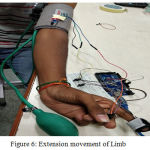 |
Figure 6: Extension movement of Limb.
|
Results and Discussion
The data as displayed in Fig. 9 was collected from 19 subjects. All the readings were taken under one minute. For each subject the cuff pressure is maintained at 35 mm of Hg and flexion angle was measured using goniometer. The goniometer is adjusted to provide easy movement. The proximity sensor is fixed on top of the cuff so as to detect the bending limb movement as a count. There is an elevation in the readings of temperature and pulse rate as the exercise progresses. The flexion angle varies between 49 degrees to 43 degrees which is quite similar to that of normal hand movement though no fully optimum. The load is not varied during the exercise and pressure leakage kept as minimal as 2 mm of Hg.2 The variation in pulse rate and temperature are visibly seen i.e. for every fraction of change in temperature between each subject, pulse rate is higher for those with elevated body temperatures. Increase in number of counts is also proportional to increase in pulse rate for most cases although other factors can cause slight deviation from the proposed concept. The message is received at the receivers end with the readings of the temperature, pulse rate and number of counts together as an SMS via GSM. Increase in pulse rate signifies a slight chance of hypertension which indirectly causes variation in temperature.8 The angle obtained is the average angle made by the limbs during one set. The goniometer used here is digital thus easy for the subject to read and record them.
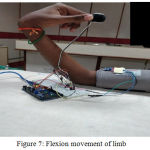 |
Figure 7: Flexion movement of limb.
|
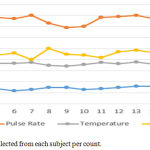 |
Figure 8: Shows the readings collected from each subject per count.
|
Conclusion
From the results and preliminary analysis as shown in Fig. 9. it is clear that temperature and pulse rate are directly proportional to each other provided the cuff pressure and other parameters are kept constant. So as the exercise progresses increase in heart rate results in increase in temperature and vice-versa. The count is restricted to 10-12 times since the repetitions has to be slow and gradual and should be done within a minute since occlusion can be applied per minute per routine as over pushing the limit can cause arterial and muscular damage.
Acknowledgment
We would like to extend our sincerest gratitude to the department of biomedical engineering for their constant support and priceless advice and suggestions regarding this project.
References
- Jan T. G., van Vliet L., KooijmanM and Maria T. E. H. Venous cuff pressures from 30 mmHg to diastolic pressure are recommended to measure arterial inflow by plethysmography. in J Appl Physiol. 2003;95(1):342-347.
CrossRef - Schuren K. M. Pascal’s law and dynamics of compression therapy. in International Angiology. 2010;29(5):431-435.
- Salomi S. T., Mr. Saraswat A., Shashwat A and Dr. Bharti V. Sensing Heart beat and Body Temperature Digitally using Arduino in.1721-1724.
- Allen J. Photo plethysmography and its application in clinical physiological measurement. in Physiological Measurement. 2007;28(3):1-39.
CrossRef - Wellington. Real Time Pulse Rate Monitoring System using Arduino Uno and GSM Technology in. 2017;4(19):292-295.
- Egypt. Infrared Object Detection Sensor in. 1:10.
- Johevajile K. N M., Kisangiri M., Machuve D. Deign of Low Cost Blood Pressure and Body Temperature interface. International Journal of Emerging Science and Engineering (IJESE) ISSN. 2013;1(10):2319– 6378.
- Miyai N., Arita M., Miyashita K.,Mori-oka I., Shiraishi T., Nishio I. Blood Pressure Re-sponse to Heart Rate During Exercise Test and Risk of Future Hy-pertension. Hypertension. 2002;39:761-766. https://doi.org/10.1161/hy0302. 105777.
- Zhen G. X and Menon C. Towards the development of a wearable feedback system for monitoring the activities of the upper-extremities. Journal of Neuro-Engineering and Rehabilita-tion. 2014.
- Dufour A., Candas V. Ageing and thermal re-sponses during passive heat exposure: sweating and sensory as-pects. European Journal of Applied Physiology May. 2007;100(1):19–26. https://doi.org/10.1007/s00421-007- 0396-9.







